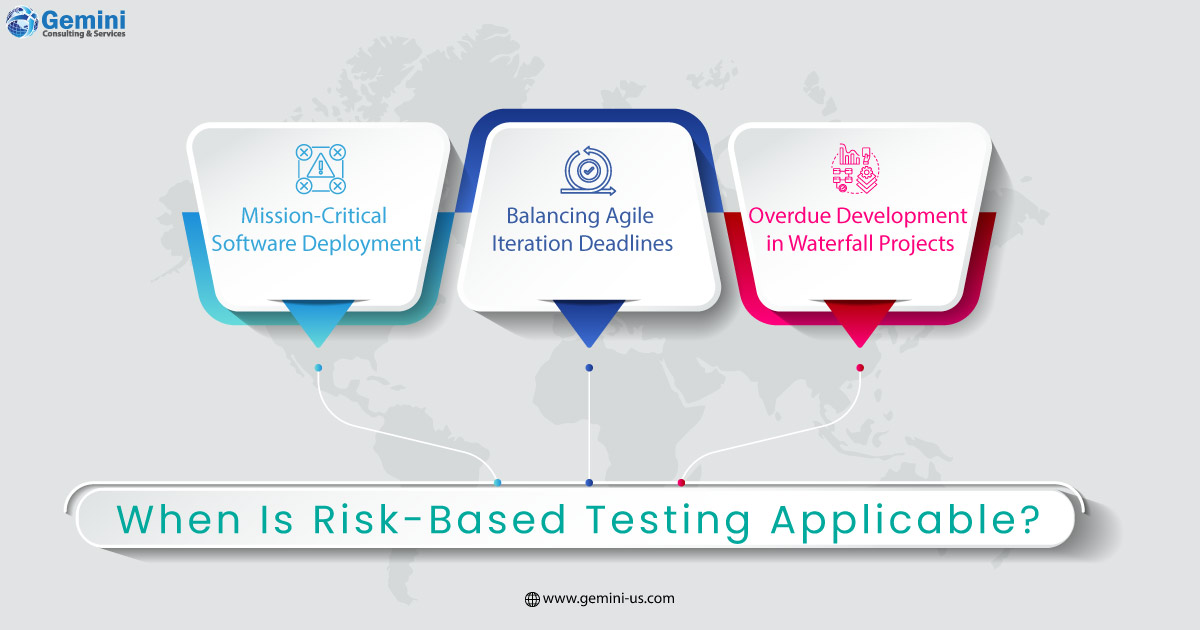In a rapidly evolving technological landscape, applications now find themselves hosted across various cloud support systems, operating systems, multiple platforms, and intricate IT infrastructures. Any disruption within this complex ecosystem has the potential to adversely affect the software’s final output.
Additionally, end-users today scrutinize applications for their features and usability, placing quality at the forefront of software delivery considerations. To meet these demands and continually improve within shorter timeframes, it is imperative to address the challenges that testers face when working with limited testing windows, often receiving builds for testing at the eleventh hour. Time and resources often run scarce and achieving 100% automation coverage presents its own set of difficulties.
This is where Risk-Based Testing (RBT) steps in.
What is Risk-Based Testing?
RBT revolves around assessing product risks to predict and mitigate the likelihood of specific features or functionalities failing in production well in advance. Moreover, it aids in quantifying the impact on the business in terms of costs and potential damages, utilizing a prioritization technique for test cases. Essentially, RBT prioritizes tests for the essential features, modules, and functionalities of a product or application, guided by the understanding of the probability of a particular functionality failing in production and the consequences thereof.
RBT is an approach that involves teams planning and identifying test scenarios based on project-specific risk criteria. While the QA team may still maintain a comprehensive list of essential tests, this approach has proven highly effective in identifying critical tests from both the customer and business perspectives through meticulous analysis.
By adopting Risk-Based Testing, organizations can significantly reduce the likelihood of top business risks materializing and adversely impacting operations. These risks can be promptly identified by customers and addressed early in the software development life cycle. It’s important to note that simply increasing the number of test cases does not guarantee software stability; instead, the focus should be on meeting customer expectations for each release. Striking a balance that optimizes the nature of testing while maximizing the benefits through reasonable efforts is crucial, especially when testing timelines are tight and resources are limited.
The RBT approach is instrumental in optimizing QA efforts and extracting the maximum testing benefits while minimizing business risks.

There are several scenarios where Risk-Based Testing (RBT) proves to be particularly valuable. Some of them are given below.
- Mission-Critical Software Deployment
Mission-critical applications, such as those facilitating critical financial transactions (e.g., banking applications) or managing and analyzing vital patient health data (e.g., Electronic Health Record systems in hospitals), demand meticulous testing. These apps span various devices and often contain high-risk modules that require thorough testing.
- Balancing Agile Iteration Deadlines
Agile methodologies emphasize iterative development, but sometimes quality assurance teams encounter challenges in estimating the right amount of time and effort for each iteration. In such cases, adopting a risk-based testing approach within Agile can help by focusing testing efforts on identified risks, making it easier to define testing goals.
- Overdue Development in Waterfall Projects
For projects following the Waterfall model, the agile risk-based testing approach is invaluable. It accurately estimates testing efforts to reduce residual product risk before software transitions to production. It encompasses test analysis, planning, estimation, design, execution, and reporting outcomes. Risk-based testing concentrates on:
- High-risk areas where defects have a high likelihood.
- Critical business functionalities.
- Frequently used features and functions.
- Security-related functionalities.
- Newly implemented changes in the application.
Who Should Utilize Risk-Based Testing and Why?
Risk-based testing establishes a framework that promotes standard and transparent communication within teams. It brings risks to the forefront, making them easier to address. This approach ensures that software applications undergo thorough testing within the available time frame and budget constraints. Most importantly, it allows teams to tackle critical issues before releasing software applications to end-users.
Developers can also leverage risk-based testing to identify and mitigate risks early in the development process. This gradual risk reduction minimizes the cost and impact of defects discovered later in the development cycle or after the software application’s release.
Teams involved in the software development lifecycle responsible for assessing critical software risks typically include:
- Product owners
- Solution architects
- Subject Matter Experts (SMEs)
- Developers with a grasp of application dependencies
- Quality Assurance (QA) testers

The Objectives of Risk-Based Testing
Establish a well-defined process for discussing potential risks among the stakeholders mentioned above.
Strike a balance between customer needs and developer constraints in risk management.
Work within specified budget and timeline parameters while ensuring software quality.
Prioritize features based on customer requirements, transforming them into a hierarchical set of testing requirements.
It’s worth emphasizing that risk-free software fosters high-quality user experiences and drives positive revenue streams. Partner with Gemini Consulting & Services to implement Risk-Based Testing. Contact us to learn more about implementing Risk-Based Testing (RBT) for your software infrastructure.
Advantages of Risk-Based Testing
Enhanced Customer Focus
This software testing approach places a direct emphasis on identifying potential critical risks that can impact customers. By allowing the testing of specific features, it significantly improves e-business performance, leading to a more customer-centric approach.
Improved Software Quality
Prioritization is a cornerstone in elevating software quality. Concentrating efforts on risks that pose a higher threat to the application’s performance and thoroughly testing vital features and functions ensures an overall increase in software quality.
Structured Testing System
Establishing well-defined timeframes enables the establishment of test execution priorities. Various test suite templates are available for implementation. When risks are identified and their impact quantified, stakeholders can make informed decisions about what to test, where to start, and when to conclude testing. This structured approach is invaluable for organizing the multitude of tests in every development project.
Risk-based testing empowers teams to work with a quantifiable parameter, which is a risk, to determine the priority of tests. Quality Assurance (QA) professionals can then accurately arrange tests in a hierarchy that serves the best interests of the software, the customer, and the overall business owner’s objectives.



